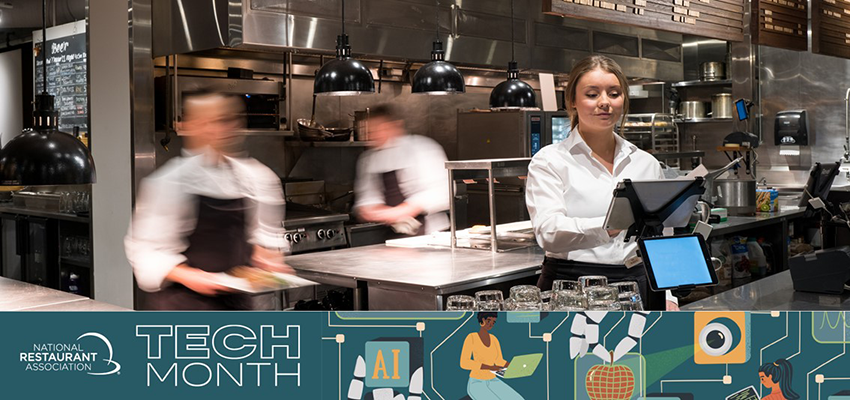AI on the menu: A restaurateur’s intro to AI

At its simplest level, artificial intelligence (AI) is the science of making machines smart, like us. This simulation of human intelligence in machines is accomplished through machine learning. Machine learning is when computers essentially are programmed to teach themselves without explicit programming. It does this by analyzing vast amounts of data, recognizing patterns, and making predictions or suggestions based on that data. It then applies that learning to new data.
Beneath the broad and overarching term of AI, there are different types of AI. For the restaurant industry, the most valuable types are categorized within Narrow AI.
Narrow AI is designed to perform specific tasks and can’t go beyond its limitations. It’s become a part of our everyday lives through conversational assistants like Apple’s Siri and Domino’s Dom; facial recognition software; and recommendation tools. Narrow AI is the most common type of AI we experience. It’s also the most common type of AI used in the restaurant industry.
We’d be remiss if we didn’t mention Generative AI and Large Language Models (LLMs), like ChatGPT. Both are considered machine learning within Narrow AI.
Why does AI matter to the restaurant industry?
Since AI is the development of computer systems that can perform tasks such as visual perception, speech recognition, decision-making, and problem-solving, it has many useful applications within the restaurant industry. It can improve operational efficiency and enhance customer experiences. By using AI, restaurant owners can remain competitive and responsive to shifts in customer needs in an ever-changing environment.
How can a restaurant use AI?
There are several ways that AI can be deployed in a restaurant setting to improve operations and customer experiences:
- Chatbots: Chatbots are AI-powered virtual assistants that can interact with customers through text or voice. They can handle customer inquiries, take orders, make reservations, and provide personalized recommendations.
- Computer vision: Computer vision AI technology enables machines to analyze visual data, such as images or videos. In a restaurant setting, computer vision can be used for tasks like facial recognition for security and staff, analyzing food quality, or monitoring inventory levels.
- Predictive analytics: Predictive analytics AI uses historical data to make predictions about future outcomes. In the restaurant industry, predictive analytics can be used to forecast customer demand, optimize inventory management, and improve menu planning.
What can (and can’t) AI do for restaurants?
AI can bring numerous benefits to restaurant owners/operators. It can optimize operations through task automation and predictive modeling. It can improve customer experience through improved customer service. AI-powered systems can streamline order taking, improve accuracy, and reduce wait times. They can provide personalized recommendations based on customer preferences and past behavior, leading to increased customer satisfaction and loyalty. AI can also analyze data to identify trends, optimize pricing strategies, manage inventory, and improve marketing campaigns.
While AI has many uses, it has limitations as well. AI is not capable of human emotions, creativity, or intuition. It relies on data and algorithms to make decisions, which means it may not always understand or respond appropriately to complex or nuanced situations. Plus, AI requires continuous training and monitoring to ensure accuracy and avoid biases.
What are important considerations for AI implementation?
Deploying AI for a restaurant requires some research and planning. Successful implementation involves selecting the right AI technologies to integrate into existing systems and training staff to manage and use those AI-powered solutions effectively. In addition to developing an implementation roadmap, it's important to assess the financial and time investment. And you should take ethical concerns, such as data privacy and security, into account when deploying AI.
AI has the potential to revolutionize the restaurant industry by improving operational efficiency and customer experiences. By leveraging AI technologies, owners and operators can streamline operations, improve staff support, and deliver great customer experiences that drive revenue and loyalty. But it’s important to understand the limitations of AI and consider the investment and ethical implications before deploying AI solutions.
Next up: How AI can improve front-of-house engagement with customers. We explore how AI-powered systems can enhance customer interactions, personalize experiences, and drive customer satisfaction and loyalty.
Recommended reading:
1. "The AI Advantage: How to Put the Artificial Intelligence Revolution to Work" by Thomas H. Davenport
2. "Human + Machine: Reimagining Work in the Age of AI" by Paul R. Daugherty and H. James Wilson
-
ParadoxParadox is the conversational recruiting software behind the world’s first Conversational ATS. Paradox is helping recruiters and hiring managers save hours every day on manual tasks by automating candidate screening, interview scheduling, and reminders, while delivering a world-class, frictionless and consumer-like mobile candidate experience.Learn more
We serve some of the industry's leading clients, including Chipotle, Darden, Flynn, Focus Brands, Bloomin' Brands, Peet's Coffee, Taco Bell, Dunkin' and more.
Subscribe
Sign-up for weekly recaps of the latest Tech Month content.
